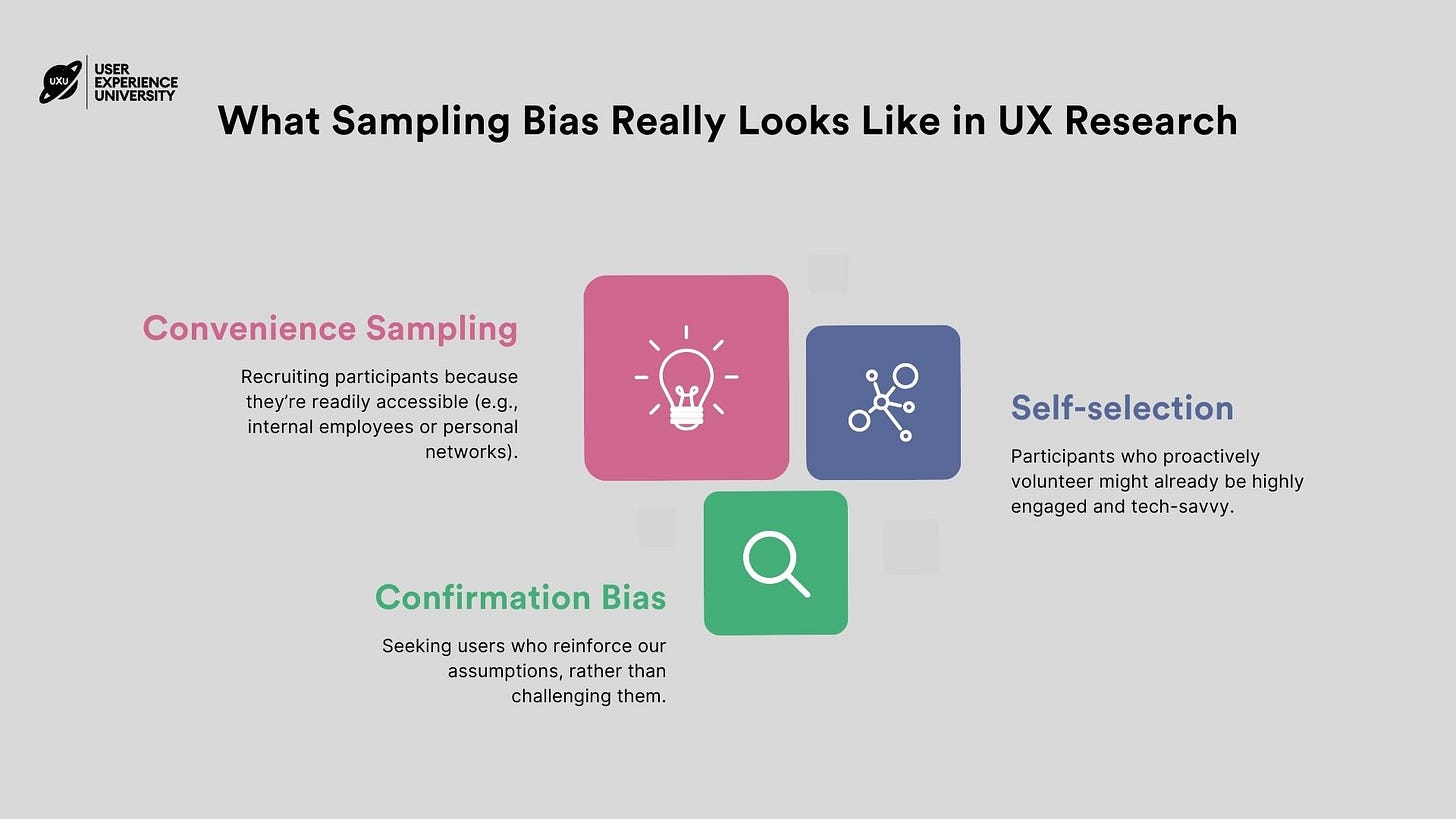Is Your UX Research Truly Representative—Or Just Convenient?
Are We Listening to the Wrong Voices?
When we run studies, we strive to capture genuine insights. But realistically, we often talk to people who are the easiest to reach: tech-savvy friends, online survey respondents, or users who eagerly volunteer for every interview.
It's practical. It's quick. But is it accurate?
A recent study by UserGuiding found that 94% of negative user feedback is directly linked to overlooked design issues—often resulting from biased early research (UserGuiding).
That means, without realizing it, we’re building products that serve some groups exceptionally well—and unintentionally excluding many others.
Let’s unpack why this happens, and what we, as UX researchers, can realistically do about it.
Why Our Research Often Leaves Key Users Out
What Sampling Bias Really Looks Like in UX Research
Real-Life Examples of Unintentional Bias
Four Realistic Steps to Improve Your Research Diversity
How to Advocate for Inclusive Research Internally
Tool of the Week: User Interviews—Broaden Your Participant Pool
Resource Corner: Essential Reads for Inclusive UX Research
Conference: Beyond UX: Growth, Jobs & Industry Insights (Win a FREE ticket to UXCON '25)
🔍 Why Our Research Often Leaves Key Users Out
Think back to your last usability test or interview session. Who showed up?
If your answer is mostly younger, digital natives, or users very similar to each other, you’re not alone. UX research frequently suffers from a lack of diversity—not because we're intentionally biased, but because convenience often drives recruitment decisions.
A Nielsen Norman Group report highlights that many UX studies rely on convenient recruiting methods (e.g., online panels, personal networks) that skew towards certain demographics (nngroup.com)
As a result, UX research often unintentionally favors younger, well-educated, and digitally comfortable participants, while other groups remain underrepresented (usertesting.com)
This isn't just theory. It's affecting your product’s usability right now.
🛑 What Sampling Bias Really Looks Like in UX Research
Sampling bias isn't always obvious, but here’s how it commonly appears:
Real-Life Examples of Unintentional Bias
A banking app developed using feedback mainly from tech-savvy millennials unintentionally excluded older users, leading to poor adoption rates among seniors.
A health-monitoring app designed from research primarily conducted on physically active users failed to accommodate those with mobility or vision impairments.
Bias isn’t theoretical—it’s impacting real users daily.
Four Realistic Steps to Improve Your Research Diversity
Here’s what you can do now—no fluff, just practical actions:
1. Broaden Participant Recruitment Channels
Stop relying solely on your usual methods. Consider partnerships with community groups, local meetups, or external platforms like User Interviews to reach a wider demographic.
2. Offer Flexible Participation Options
Not everyone can participate during work hours or travel to your office. Offer remote, after-hours, or asynchronous sessions.
3. Make Diverse Recruitment a Priority
Set clear goals for representation and communicate them to your stakeholders. Explicitly state that diverse perspectives are crucial for accurate insights.
4. Regularly Audit Your Methods
Invite external review or peer feedback on your recruitment strategy to identify biases you might miss.
📢 How to Advocate for Inclusive Research Internally
You might already know diversity is essential—but stakeholders need convincing. Here's how to make the case internally:
Link inclusion directly to revenue or engagement metrics: Show how designing for broader user groups increases user adoption and satisfaction.
Share examples of competitors or industry leaders who saw measurable improvements from inclusive research practices.
Educate stakeholders on the business risks of biased research—lost customers, negative reviews, and overlooked market segments.
🛠️ Tool of the Week: User Interviews—Broaden Your Participant Pool
User Interviews provides UX researchers direct access to diverse, vetted user groups, allowing you to:
Easily recruit participants across different demographics and locations.
Schedule and manage sessions seamlessly.
Quickly uncover insights from typically underrepresented user groups.
🔗 Explore User Interviews here
📚 Resource Corner: Essential Reads for Inclusive UX Research
Guide: Inclusive UX Research Methods – Careerfoundry
🎙️ [In-Person Meet-up]: Join Us for an Evening of Growth, Jobs & Industry Insights
UX is shifting, and so are career opportunities. Whether you’re a seasoned pro, transitioning careers, or a student breaking into the field, this event gives you insider knowledge on hiring trends, career growth, and the future of UX.
Join us at the UXCON Spring Meetup with UXPD (UX + Product Design, DC) for an insightful in-person discussion about UX careers, industry shifts, and what’s next for the field.
Attend and stand a chance to win a FREE ticket to UXCON '25!!!
Final Thought: Inclusive Design Starts at the Research Stage
Your design is only as good as your research. If key voices are missing early, your product won't magically become inclusive later.
The challenge isn't perfection—it's progress.
Let’s make a commitment to genuinely listen to users we've previously overlooked.






